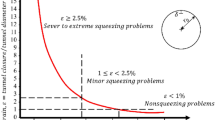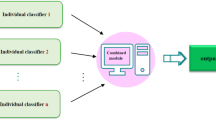Abstract
Tunnel squeezing occurs when time-dependent rock creep produces large tunnel convergence. The occurrence of tunnel squeezing may result in buget increase and time waste during tunnel construction. The aim of this study was to propose a robust classifier ensemble to predict squeezing conditions in rock tunnels. Seven individual machine learning classifiers were aggregated using weighted voting methods to establish the classifier ensemble. The weight and hyperparameters of each individual classifier were tuned using the firefly algorithm. The classifier ensemble was trained and tested on a dataset collected from published literature. Missing values in the database were replaced by various imputation methods. The results indicate that the proposed classifier ensemble achieved an accuracy of 96%, higher than that of the traditionally used individual classifiers. This robust ensemble method can be applied to other classification problems in civil engineering.










Similar content being viewed by others
References
Alexandre LA, Campilho AC, Kamel M (2001) On combining classifiers using sum and product rules. Pattern Recogn Lett 22:1283–1289
Andrews DF (1974) A robust method for multiple linear regression. Technometrics 16:523–531
Aydan Ö, Akagi T, Kawamoto T (1993) The squeezing potential of rocks around tunnels; theory and prediction. Rock Mech Rock Eng 26:137–163
Barla G (1995) Squeezing rocks in tunnels. ISRM News Journal 2:44–49
Barton N, Lien R, Lunde J (1974) Engineering classification of rock masses for the design of tunnel support. Rock Mech 6:189–236
Chen J, Shao J (2000) Nearest neighbor imputation for survey data. J Off Stat 16:113
Cortes C, Vapnik V (1995) Support-vector networks. Mach Learn 20:273–297
Dhanabal S, Chandramathi S (2011) A review of various k-nearest neighbor query processing techniques. Int J Comput Appl 31:14–22
Dwivedi R, Singh M, Viladkar M, Goel R (2013) Prediction of tunnel deformation in squeezing grounds. Eng Geol 161:55–64
Elbaz K, Shen S-L, Zhou A, Yuan D-J, Xu Y-S (2019) Optimization of EPB shield performance with adaptive neuro-fuzzy inference system and genetic algorithm. Appl Sci 9:780
Fawcett T (2006) An introduction to ROC analysis. Pattern Recogn Lett 27:861–874. https://doi.org/10.1016/j.patrec.2005.10.010
Feng X, Jimenez R (2015) Predicting tunnel squeezing with incomplete data using Bayesian networks. Eng Geol 195:214–224
Fritz P (1984) An analytical solution for axisymmetric tunnel problems in elasto-viscoplastic media. Int J Numer Anal Methods Geomech 8:325–342
Gandomi AH, Yang X-S, Talatahari S, Alavi AH (2013) Firefly algorithm with chaos. Commun Nonlinear Sci Numer Simul 18:89–98
Gao F, Stead D, Kang H (2015) Numerical simulation of squeezing failure in a coal mine roadway due to mining-induced stresses. Rock Mech Rock Eng 48:1635–1645. https://doi.org/10.1007/s00603-014-0653-2
Guan Z, Jiang Y, Tanabashi Y, Huang H (2008) A new rheological model and its application in mountain tunnelling. Tunn Undergr Space Technol 23:292–299
Hasanpour R, Rostami J, Ünver B (2014) 3D finite difference model for simulation of double shield TBM tunneling in squeezing grounds. Tunn Undergr Space Technol 40:109–126
Hecht-Nielsen R (1992) Theory of the backpropagation neural network[M]//Neural networks for perception. Academic Press 65–93
Hoek E (2001) Big tunnels in bad rock. J Geotech Geoenviron 127:726–740
Hoek E, Guevara R (2009) Overcoming squeezing in the Yacambú-Quibor tunnel, Venezuela. Rock Mech Rock Eng 42:389–418
Hoek E, Marinos P Tunnelling in overstressed rock. In: Proceedings of the Regional Symposium of the International Society for Rock Mechanics, EUROCK, 2009. pp 49–60
Jimenez R, Recio D (2011) A linear classifier for probabilistic prediction of squeezing conditions in Himalayan tunnels. Eng Geol 121:101–109. https://doi.org/10.1016/j.enggeo.2011.05.006
Li N (2017) Predicting underground tunnel hazards using machine learning techniques. PhD thesis, Universidad Politécnica de Madrid, Spain
Li L, Hu Q, Wu X, Yu D (2014) Exploration of classification confidence in ensemble learning. Pattern Recogn 47:3120–3131
Little RJ, Rubin DB (2002) Statistical analysis with missing data. Wiley, New York
Lyu H-M, Shen S-L, Zhou A-N, Zhou W-H (2019a) Flood risk assessment of metro systems in a subsiding environment using the interval FAHP-FCA approach. Sustain Cities Soc 50:101682. https://doi.org/10.1016/j.scs.2019.101682
Lyu H-M, Shen S-L, Zhou A, Yang J (2019b) Perspectives for flood risk assessment and management for mega-city metro system. Tunn Undergr Space Technol 84:31–44
Malarvizhi M, Thanamani A (2012) K-NN classifier performs better than K-means clustering in missing value imputation. IOSR J Comp Eng (IOSRJCE) 6:12–15
McRae GJ, Tilden JW, Seinfeld JH (1982) Global sensitivity analysis—a computational implementation of the Fourier Amplitude Sensitivity Test (FAST). Comput Chem Eng 6:15–25. https://doi.org/10.1016/0098-1354(82)80003-3
Peng C-YJ, Lee KL, Ingersoll GM (2002) An introduction to logistic regression analysis and reporting. J Educ Res 96:3–14
Phienwej N, Thakur P, Cording E (2007) Time-dependent response of tunnels considering creep effect. Int J Geomech 7:296–306
Pianosi F, Sarrazin F, Wagener T (2015) A Matlab toolbox for global sensitivity analysis. Environ Model Softw 70:80–85. https://doi.org/10.1016/j.envsoft.2015.04.009
Quinlan JR (1986) Induction of decision trees. Mach Learn 1:81–106
Rish I An empirical study of the naive Bayes classifier. In: IJCAI 2001 workshop on empirical methods in artificial intelligence, 2001. vol 22. pp 41–46
Sakurai S (1997) Lessons learned from field measurements in tunnelling. Tunn Undergr Space Technol 12:453–460
Shalabi F (2005) FE analysis of time-dependent behavior of tunneling in squeezing ground using two different creep models. Tunn Undergr Space Technol 20:271–279
Shang Y, Xue J, Wang S, Yang Z, Yang J (2004) A case history of tunnel boring machine jamming in an inter-layer shear zone at the Yellow River diversion project in China. Eng Geol 71:199–211
Shrestha GL, Broch E (2008) Influences of the valley morphology and rock mass strength on tunnel convergence: with a case study of Khimti 1 headrace tunnel in Nepal. Tunn Undergr Space Technol 23:638–650
Singh B, Jethwa J, Dube A, Singh B (1992) Correlation between observed support pressure and rock mass quality. Tunn Undergr Space Technol 7:59–74
Sokolova M, Lapalme G (2009) A systematic analysis of performance measures for classification tasks. Inf Process Manag 45:427–437
Sterpi D, Gioda G (2009) Visco-plastic behaviour around advancing tunnels in squeezing rock. Rock Mech Rock Eng 42:319–339
Sun J, Zhang J, Gu Y, Huang Y, Sun Y, Ma G (2019a) Prediction of permeability and unconfined compressive strength of pervious concrete using evolved support vector regression. Constr Build Mater 207:440–449
Sun Y et al (2019b) Determination of Young’s modulus of jet grouted coalcretes using an intelligent model. Eng Geol 252:43–53
Sun Y, Zhang J, Li G, Wang Y, Sun J, Jiang C (2019c) Optimized neural network using beetle antennae search for predicting the unconfined compressive strength of jet grouting coalcretes. Int J Numer Anal Methods Geomech 43:801–813
Tóth N, Pataki B (2008) Classification confidence weighted majority voting using decision tree classifiers. Int J Intell Comput Cybern 1:169–192
Uebersax JS (1982) A generalized kappa coefficient. Educ Psychol Meas 42:181–183
Zhang J, Jiang F, Yang J, Bai W, Zhang L (2017) Rockburst mechanism in soft coal seam within deep coal mines. Int J Min Sci Technol 27:551–556
Zhang J, Ma G, Huang Y, Aslani F, Nener B (2019a) Modelling uniaxial compressive strength of lightweight self-compacting concrete using random forest regression. Constr Build Mater 210:713–719
Zhang N, Shen S-L, Zhou A, Xu Y-S (2019b) Investigation on performance of neural networks using quadratic relative error cost function. IEEE Access 7:106642–106652
Zhifa Y, Zhiyin W, Luqing Z, Ruiguang Z, Nianxing X (2001) Back-analysis of viscoelastic displacements in a soft rock road tunnel. Int J Rock Mech Min Sci 38:331–341
Acknowledgements
Junfei Zhang and Dong Li contribute equally to this paper and should be regarded as co-first authors.
Funding
The first author is supported by the China Scholarship Council (grant number: 201706460008).
Author information
Authors and Affiliations
Corresponding authors
Electronic supplementary material
ESM 1
(DOCX 32 kb)
Rights and permissions
About this article
Cite this article
Zhang, J., Li, D. & Wang, Y. Predicting tunnel squeezing using a hybrid classifier ensemble with incomplete data. Bull Eng Geol Environ 79, 3245–3256 (2020). https://doi.org/10.1007/s10064-020-01747-5
Received:
Accepted:
Published:
Issue Date:
DOI: https://doi.org/10.1007/s10064-020-01747-5




